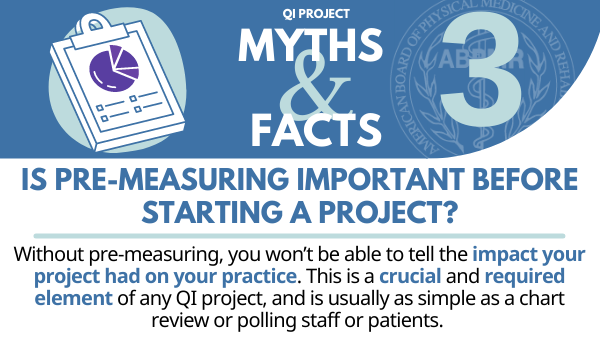CC
QI Project Series: Pre-measure Twice, Change Once

In this News Center series, we discuss common Quality Improvement (QI) project misconceptions and give the real facts about the process of completing a project. For more information on QI projects, to see project topics, and to begin your own project, visit the QI project resources page.
Myth: I don’t need to pre-measure before I start my project; I’ll just make a change and see what happens.
Truth: If you don’t pre-measure, you won’t be able to tell whether or how much your project actually impacted your practice. Pre-measure is a crucial and required element of any QI project; don’t miss it!
Without pre-measuring, you have no starting point with your project; it provides the data you need in order to see the difference your project makes.
Pre-measuring doesn’t have to take long or involve a drawn-out process—it’s usually as simple as a chart review or polling your staff or patients. This step also helps you set a reasonable goal for your project, since pre-measuring will give you an idea of current state and may spark ideas for the specific change that needs to be made.
Some recent examples…
Dr. George Deimel evaluated whether transitioning to a virtual scribe service to record patient encounters in real time could make a positive change in his practice. Before beginning his project, he measured the time, cost, and energy being spent in his practice without the virtual scribe. Dr. Deimel and his team then saw a drastic difference in cost-effectiveness, efficiency, productivity, and job satisfaction after transitioning to the virtual scribe, something that would have been difficult to assess without pre-measuring. Not only did the change save thousands of dollars and hours of time, but thanks to involving his staff in pre-measuring, Dr. Deimel also found feelings of burnout and stress had improved among the staff. Read Dr. Deimel’s full project.
Dr. Brittni Micham was a resident when she completed her QI project to lower the rate of transfers to acute care after admission to inpatient rehabilitation. Before beginning her project, Dr. Micham pre-measured the average age of patients being transferred, their diagnosis and symptoms, and the top reasons for transfer. Her QI project goal was designed to address these signs, symptoms, and reasons for readmissions to reduce the transfer rate by 5 percent. By pre-measuring, she identified the trends among patients who were transferred and implemented effective changes based on what she discovered while pre-measuring. Read Dr. Micham’s full project.
Don’t skip pre-measuring!
Not only will this important step help you measure what has changed after your project is complete, but it will be useful in setting a goal for your project. Pre-measuring doesn’t have to be time-consuming and will be beneficial as you look at exactly what your project accomplished.
For more resources, visit the QI project resources page, and see examples of completed projects on the ABPMR News Center.

